Previously, I wrote about Joseph Campbell's Hero's Journey as a mental model for evolutionary change management. It was perfect for my needs. Now, let me introduce you to the implementation of this mental model as an evolutionary change management tool.
I use this storification technique to understand what the organization wants first (needs later) and explain how to accommodate them with a road map (as seen in Step 1). I start by building a shared understanding of the current situation and continue with possible next steps. After this, the journey can be designed all together.
Throughout time, my usage of this technique has evolved and branched out to classes of services that serve multiple purposes. I realize now that I need to summarize them here and write about the base.
Here are The Hero's Journey Classes of Service (CoS):
1. Busy C-Level Lightning Pitch or The Hook (max. 30mins)
For the people who "think" they just need the overview and will have no part in it. Show the journey, ask the stressor, and get a follow-up meeting for a handshake.
2. Skin In The Game Warm-up Session (1 - 2hrs)
For the people who are "in the system"; who have their neck in the line voluntarily or not. Explain the journey in detail, ask the stressor, layout the next steps. Gain a handshake and engage in other workshops for the coming weeks.
3. Collaborative Crowd With Dedicated Time (2hrs to Half-day)
For people with a leader who wants to do something about it. Explain the journey in detail, have a handshake and identity workshop, layout the next steps for the coming weeks.
Don't hesitate to spice it up, as I can't describe here all the gestures and moods you'll be demonstrating in your narration of the story in this article. Remember, you need to tell an intriguing story to have their attention, so please enhance this experience with your storytelling skills.
You can support your workshop with other techniques and practices such as; STATIK[1], Agendashift[2], Cynefin[3], Clean Language[4], Liberating Structures[5] for more effectiveness and structure if you like. I usually go with the flow according to the attendees' mood.
Step 1. Visualize
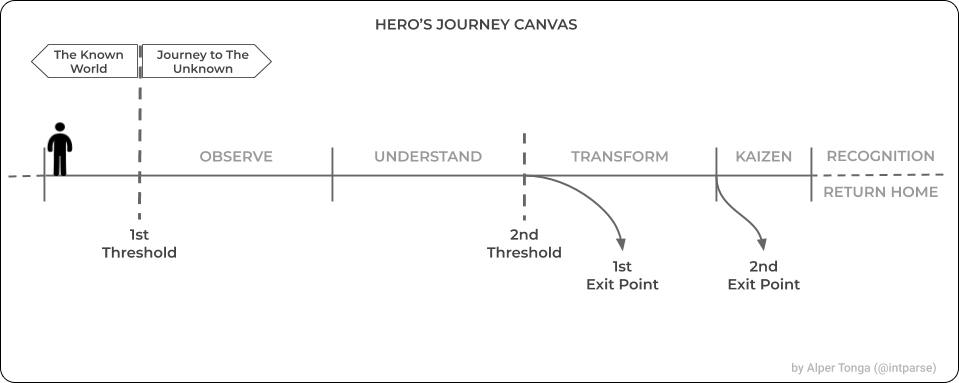
Draw the fundamentals, first, and start engaging visually. The drawing should not reveal too much, yet. But it should be intriguing enough to grab their attention and spark questions in their heads. Here is an example of what I draw.
Step 2. Refresh the Purpose
Remind them that they'll be participating in a storified workshop called "The Hero's Journey". Say that this workshop is mainly for you to understand what is requested from the organization. Emphasize that it is their job to provide this shared understanding of "what is requested" to you, all together. That is why all of them are present here. In the end, this will be their journey and they will be one of the heroes.
Underline that after establishing this shared understanding, it is possible for you to describe how you think you'll accommodate their wants and needs in this journey.
Step 3. Narrate the Story
Start the story by pointing to the figure in the drawing and indicating it represents them. A long time ago in an organization not so far away it was all OK in their known world, but an event (stressor) had made them realize the direction they needed to go. The journey was unavoidable, so they answered the call, and leaders of the organization emerged to lead for better (Kaizen).
Step 4. Find the Motive
Here you should ask what the stressor was, the direction they wanted to take, and what they hoped to achieve through that direction. Write down these future achievements as guiding North Stars. These are what they want to see at the end of the journey.

At this step, we need to come up with indicators that would signal when the goal is reached. This will help to eliminate wishful thinking or goals with vague definitions. Ask them, how they would know if the goal has been reached. After seeing "what" indicators/proof they conclude [with confidence], then this becomes the stepping stone against which to measure whether the need has been fulfilled.
These kinds of questions will make them think about the fitness indicators and objectives that they need to be looking for. Also, this will align you and anyone who isn't in the room on shared goals better.
It's important that these goals can be seen by all, so put them on the board. This way it's easier to help people focus their conversation around these topics and decide if achievements are in their interest; skin in the game[6]. If not, a better north star should be found. This skin-in-the-game-moment is important. The more heroes personally relate to achievements, the more the ownership of the journey increases.
Step 5. Emphasize the Soul
At this point, I usually tell the attendees "since the goals are somewhat defined, the journey has a soul now". It's known what urged them (stressor) to take on the journey and the motivation for them to keep going even not fully knowing the risks; the goals, north stars, and the indicators.
Mention that leaders take the responsibility to manage risk; gather information, run controlled experiments, and learn as much as they can to minimize risk. That's what they have been doing and still doing in this workshop - learning about the risks.
Emphasize that the journey has not begun, we are still in the known world, and leaders (not managers) are needed!
Step 6. Mentor Mindset
Here, you should mention that during these risky times, such as now, a mentor can be the most useful. Someone who has been there and can guide people with knowledge from past experiences combined with present learnings. The mentor appears when the student is ready!
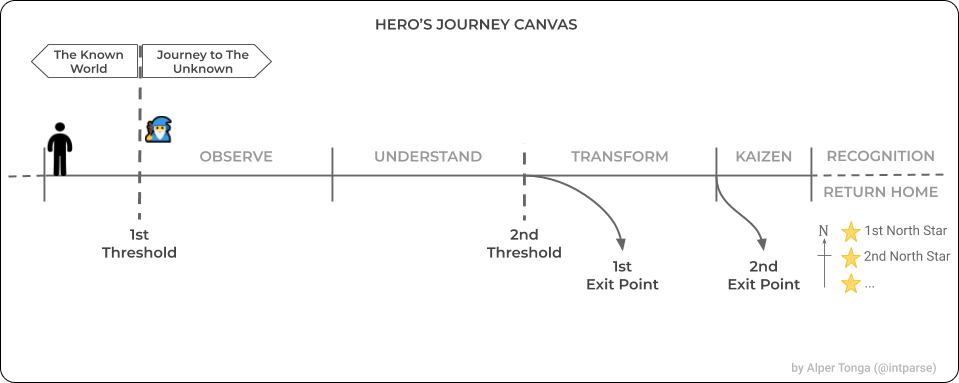
While pointing to the mentor icon, tell them that you are here to share your knowledge, so they feel safer passing the first threshold together.
The journey needs to be fruitful, all must learn from it including the mentor. Emphasize you're here to learn as well as facilitate and share knowledge. The mentor has been in similar journeys, but they all were unique; none of them can be copied and pasted into another's context. The journey should be fit for purpose.
Step 7. The Acts
Reveal some more of the journey by saying "Here is how this learning, growing, evolving journey is going to be".
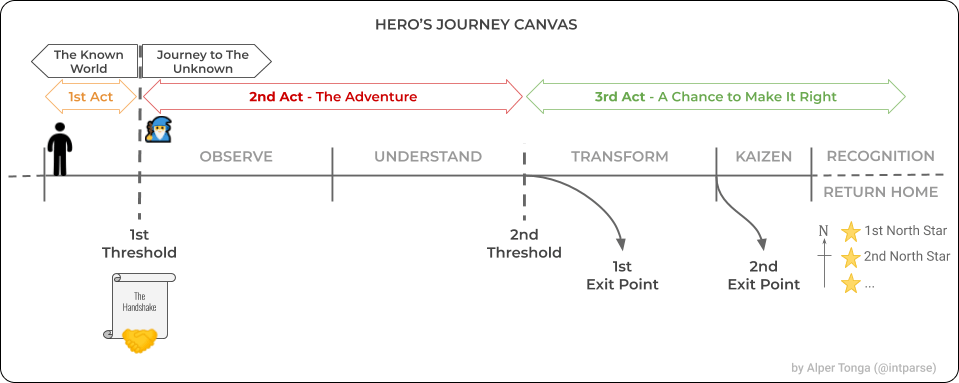
The heroes will be traveling a 3-act journey; 1st Act - The Known, 2nd Act - The Adventure, 3rd Act - A Chance to Make It Right.
The 1st Act is almost over, but still, there are a few things that need to be done; meeting the mentor and having a handshake. Only after this handshake, the first act ends (the known) and the second act (the adventure) begins.
Step 8. The Handshake
Start explaining why a handshake is needed and what it looks like. A good handshake:
- reveals the identities of the heroes; the who
- emphasizes the stressor; why they want to take this journey
- makes policies explicit to have a good start on the governance model; the how
- helps to agree on the goals to be achieved; the what
- increases the physiological safety of the people who are on the journey.

The handshake must provide a safe ground to openly question the results. This allows for a living breathing journey, journey with a soul. When it's soulless (mechanical), people do not ask questions. There is only compliance - doing something according to someone else's rules or standards. This results in no ownership, no Kaizen, and no fitness for purpose.
Every soul is unique, so every journey is unique. There is no standard one way to do it. Transformational needs are unique to each culture, to each context within the culture, and to each identity within the context.
Also, emphasize that the handshake must enable itself to evolve for better and take the form of the conduit it's in [being like water].
A Note: Here is where I usually start training a "handful of managers" on what is needed. Whether these training be on evolutionary change management (Kanban), Agile, leadership, iterative frameworks (Scrum, XP), or flow-based methods (Kanban).
I do not go on a training spree with the teams, but I do 2-hour discovery sessions on identity and goals if needed.
I have the training load talk whenever I'm explaining the handshake if the topic is relevant.
Step 9. Start With What You Do Now
After the 1st Threshold is passed, we start the 2nd Act; the adventure.
Explain that it may be called "the adventure", but we are not going to take a wild, dangerous, and ambitious path to reorganization or anything that might spark a big resistance that can't be handled - a revolution. We are in the business of evolution. Our goal is not to create resistance by dismissing the current but to become an opposition through offering alternatives.So, emphasize that in this act, we observe the environment and try to understand how the work works[7]. We do not change anything at this act if there is no punctuation point. We may suggest small experiments and alternate ways; visualizations, policy updates, monitor existing metrics, introduce new simple metrics, feedback loops, WIP (Work In Progress) Limits[8], etc.
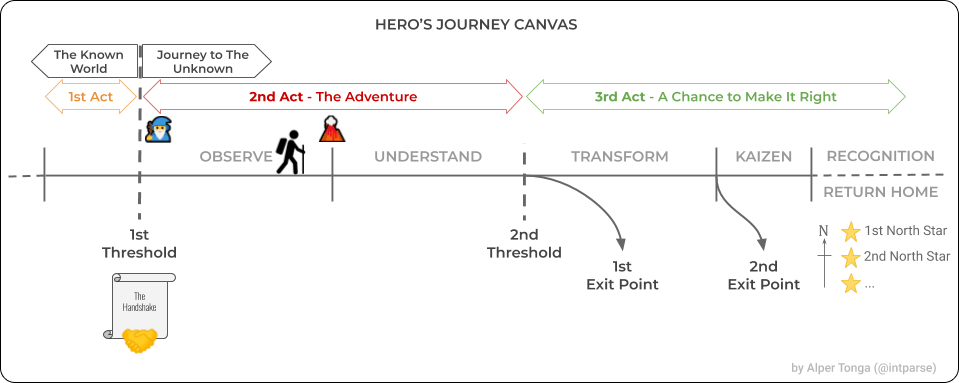
Induce small nudges to check the comfort levels and even maybe adapt new ways if people are receptive to the alternative. We offer alternates and observe what is owned or left behind, without causing resistance.
Remind that this is the act where we go after what we want by using culture's ways. We look for stressors/punctuation points during this act; an opening or an excuse to try an alternate way. It is an adventure, after all, there will be ups and downs, so let's not waste these opportunities.
We might stumble and even fail miserably during the 2nd Act. But these controlled failures will bring great wisdom that will be helpful along the journey.
Step 10. The Bitter Truth
After conducting (hopefully) several experiments and having a good contrast between what was then and what is now (Before & After with objective results), the mentor raises the curtain.
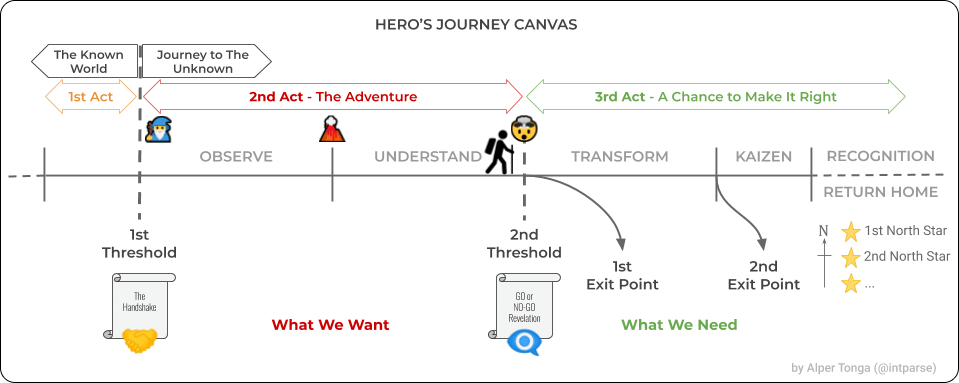
Mention that this revelation may be mind-boggling and rejected. The Fight or Flight mode is engaged hence the label the 2nd Threshold.
A Moment of Opportunity: Along the journey, if you happen to not come across any punctuation points up until here, the 2nd Threshold will be your chance. You will have the opportunity to induce a mentor-made stressor/punctuation point by highlighting before and after moments via progress reports; what was hoped to be achieved and the reality of the situation.
A formal report with an executive summary, including metrics, can do the job. Also announcing this transparently when the journey begins, at the handshake, will make it even better. This helped me a lot when I needed an upper hand during my coaching.
I highly recommend arranging an internal half-day event/summit where all people in the organization are invited for a presentation by volunteered heroes/teams/departments/tribes/squads highlighting their before and after moments.
This stressor can be designed to span over the whole journey with feedback loops; mini bi-weekly newsletters/presentations/reviews, etc.
No matter how you do it, the culture's System 1 thinking[9] will kick in. Revelation done with proof / objective results is helpful to engage the System 2 thinking. Also, giving enough time to process the results helps a long way.
Emphasize that until this point, we've been experimenting, learning together, and going after what we wanted. We were probing, observing, and understanding but not transforming. Now the mentor can exercise his/her consultant muscles and show what is needed. After all, that is why the mentor is hired; to show expertise.
In the beginning, the mentor was not qualified to consult not because (s)he had no expertise but had no context/credibility. Now the mentor has been traveling and experiencing the journey along with the culture, it's hard to dismiss his/her suggestions as easily as it was before.
The mentor is in the system and accepted by the culture, so it's time to prescribe. It's not about what we want anymore but what we need.
Step 11. The 1st Exit Point
After the bitter truth is revealed and knowledge is attained, it's time to ask ourselves if we're a "GO" or a "NO-GO". Are the heroes ready to make that meaningful change that was revealed to them?
The taste of the medicine can be too bitter to handle, so it's OK to quit here; the 1st Exit Point.
Let your audience know that this is the point where the noble cause might end. Quitting before seeing sustainable benefits is a risk; not transforming, and they are in this session to learn about the risks of this journey.
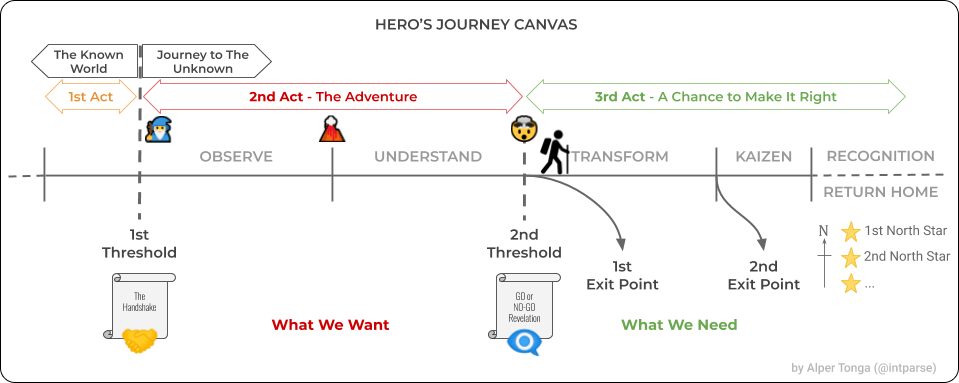
It's nothing to be ashamed of, quitting. Explain, with the following points below, why it's beneficial for both the mentor and the culture to have this exit point here.
1. You can't force people to change, period!
A culture can not live without an adequate system that resonates with the environment. When the environment changes, its system must adapt for culture to prevail. That is why it's called a culture - it behaves like bacteria (culture) in a petri dish -; it grows features, makes policies, defines norms, and evolves to adapt to the changes in its environment so it can live. In other words; you can't expect the culture to change without changing the system.
The medicine presented by the mentor usually targets the system, not the culture. And here lies the dilemma; the system can only be changed by the leaders - members of the culture. People, and cultures, change when they have motivation.
Up to this point, if we haven't built upon that motivation, we are in tough luck. Hence, the exit point.
2. The transformations should not be endless, there has to be at least one checkpoint.
No checkpoint means, no need to check for progress. People get frustrated and disoriented when they have an unlimited amount of something; things loose meaning. Not to mention Parkinson's Law; I have time therefore I can do it later.[10]
When the feeling of time running out on something they value is near, people increase their tolerance and transform, - fight mode -. And they transform fast. It's like people becoming more religious as they grow old. Call it fear or wisdom, but I'd like to think of this feeling - running-out-of-time - as a good catalyst/stressor for change. But this only works if they value it. So if we were successfully experimenting fit for purpose changes that people cared about in the 2nd act, then they will fight to get it. Otherwise, this is the point where they exit.
3. Transformations should have a safety valve for people who resist the idea of being changed.
People look for an exit - flight mode - when they are stressed. If they see one, they can program their tolerance better. This point will decrease their resistance for some time until they run out of patience. This exit point is the bottom of the J-Curve[11] (Virginia Satir's Change Model[12]). If you exceed that threshold, you'll not convince anyone to go further with you and that's when the mentor gets fired.
 Image credit: djaa.com
Image credit: djaa.com
It is recommended to have small J-Curves (Kaizen, evolution) instead of a big one (Kaikaku, revolution). Have frequent checkpoints, implement feedback loops in your journey, and definitely have the 1st Exit Point within a time frame that the culture can tolerate.
This is also a point for the culture to evaluate mentor's services. Let's not waste anyone's precious time. My precious! (Sorry, it's hard to resist that quote after all the LoTR examples that I gave in the first part of the article.)
News Flash: Let me break the news for you; you might have put your whole career in this transformation coaching / consulting path but it is not everyone's favorite, especially the people who experience it.
People are trying to run a business in a competitive environment. If you are not solving real problems but playing a transformation game, you've got things coming that will put you out of business. This is serious stuff.
So, the 1st Exit Point is a mechanism I put in the journey to ease resistance, increase tolerance for the culture, and have a skin-in-the-game moment for the mentor. It is a point where we can keep experimenting with transformation and still have tolerance for failure. At this point, they can have their choice of "GO" or a "NO-GO".
Step 12. The Proof
After receiving the "GO" from the (now wiser) heroes, we fold our sleeves and face our demons for a meaningful transformation, the 3rd act - a chance to make it right - begins.
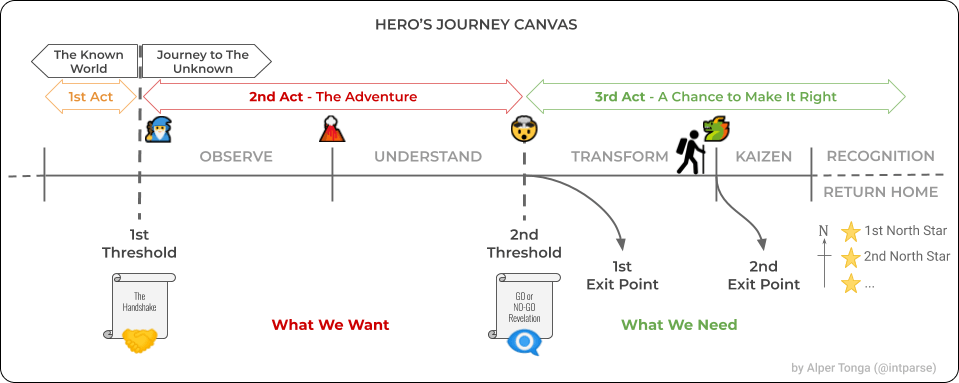
Personal Rant: Let me remind you, after coming out of that "revelation" with a prescription, you've got people watching you. Either they are rooting for you or your demise. It's bold to come up with a prescription. My dear mentor, now you'll need all the allies you can get.
People might have experimented with frameworks, best practices, and tools as far as the culture allowed in the 2nd act - the adventure -. But now you have asserted your ways into the journey with the prescription. The culture needs to change and a new system to support this change is being built thanks to your input.
Now, it's become personal. You as a mentor need to foster leadership as well as ownership or you'll, rightfully, be the one to be blamed if the transformation goes out of hands. Now you have skin in the game.
And face it, you can't be everywhere. Teach and grow people within the culture to become leaders, so you can delegate/share work. Even let them implement their solutions, that's what leaders do. You'll need leadership at all levels to share the burden as well as success. This is easier said than done, but there are ways to do it. (Hint: A Framework for Good Leadership at All Levels)
Emphasize that from now on, everything we do or suggest must present a token of accountability to show people that we are not fooling around and they can hold us accountable.
Also, for every result of actions, proof must be presented to convince people that we are transforming for better, improved our situation, and evolved.
It has to be clear to the culture, who is being changed, that we mean serious business and we don't waste their time.
Explain that now is the time to scale within the organization with feedback loops and have people involved in the process with their own ideas. That is a sure way to increase ownership; let people have something they care about, something they own, in the system. This way of ownership will make them hard to disown it.
Personal Rant 2: Imagine your children or pet, something you've put your time in to make it grow better. Something that you are proud of because you are the parent.
You can not disown your child at first sight of failure. You try to teach them so they succeed and become better. You've spent your blood and sweat for them to grow, you've sacrificed yourself for their wellbeing. You can not disown but only work hard to make them better.
And you do not accept any bad comments from outside, you protect them. You do not crawl to your space and let your hard work crumble, you fight.
That is ownership.
We might also start training more people who will be helping with the implementation of the new system.
Let your audience know that the second wave of training will happen here. The training will be held for people who are volunteering to help and maybe picked strategically. Some politics may be involved in order to gain more allies.
Remind them that the first wave of training with a handful of managers/leaders happened right after the 1st act completed. Now, we need to call upon a broader and autonomous collaboration within the organization. To increase the probability of this collaboration being a success, people need to understand the language the mentor is speaking. A formal training will help this happen.
Personal Rant 3: My approach has never put the training at the top of the list. It's always felt good when people asked for the training after they saw value in it. If you are doing a good job as a mentor, the right training at the right time with right intentions always pays-off.
Let the organization see that there is value in your approach and also let them realize that the training will add to that value. I was never questioned by the managers (CFO or other financial decision-makers) when I suggested training to them.
Encountering obstacles, seeing how the mentor deals with them, and then learning why things behave that way in training, makes a better learning journey.
So, how do you manage change with people wanting to implement their own suggestions after opening that leadership at all levels approach? You need feedback loops and a governance model. (Hint: Kanban; The Evolutionary Change Management) That is unfortunately not in the scope of this article but I'm sure you'll come up with your own solution.
But let me share with you a filtering method I use; A Framework For Good Leadership At All Levels. I also use this to help people to hold their leaders accountable without being traumatized.
A Framework for Good Leadership at All Levels
Whenever someone comes up with a suggestion, we should all ask her/him to put it in the following form, so we understand it better and see if (s)he has given a good thought.
1. The Outcome / Need
The north star that shows us the way when we are lost.
(What is the expectation/purpose? Why are we doing it? What's in it for me?)
2. The Suggestion / Experiment
The idea that we are going to execute.
(What/how are we going to do?)
3. The Duration
The time frame that we are going to see an improvement in the end.
(How long are we going to experiment?)
4. The Exit Condition
The indicators that let us know, soon, that this is not the right way to go.
(What is the condition to abort? Where is the last point to abort?)
5. The Reality Check
The proof/equation that we check against to decide the outcome has been achieved. (How do we decide if we are there yet? Have we achieved the outcome?)
Now we are nearing the end of the journey. With the feedback loops, the leaders will show progress and proof that they are achieving their goals. After the proof is obtained and dues are paid, the mentor is no longer needed. Because there is only one thing left to do, being recognized.
A good mentor knows when to exit the scene and have the others take his/her spot for better outcomes and kaizen. The mentor proudly looks back at the people who have grown to be leaders and taken over his/her job. This is the scene where the mentor slowly disappears into the sunset.
Step 13. Being Proud
Now the heroes are back home with the prize (proof), people at home better be prepared to cheer for them and recognize their efforts.
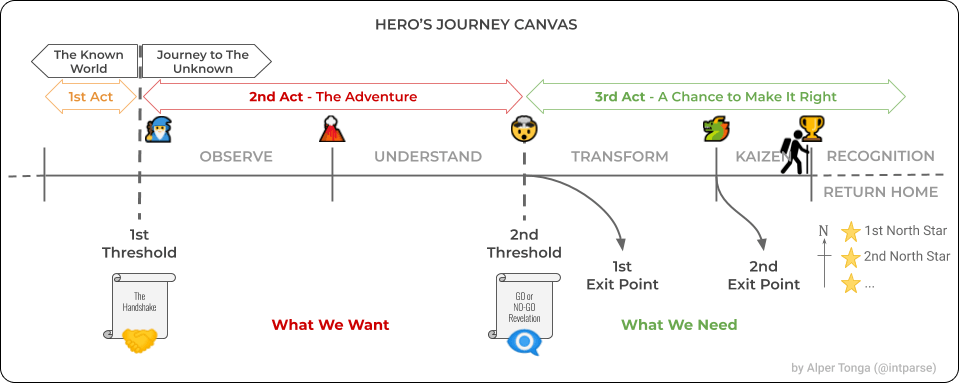
Emphasize to the management that an organization-wide recognition is in order. Heroes need to look back at the journey, reflect on it, and be proud. The recognition they receive must make them feel that "it was worth it".
Strongly point out that the management should not overlook this aspect. Otherwise, they will lose their leaders.
Conclusion
This is how I structure and present during the first meeting. We keep the findings on the board which we update frequently to see where the transformation journey is and then communicate the progress to the rest of the organization.
Reference List
- System Thinking Approach to Implementing Kanban STATIK: https://businessmap.io/blog/statik-kanban
- Agendashift The Wholehearted Engagement Model https://www.agendashift.com/
- Cynefin Framework https://en.wikipedia.org/wiki/Cynefin_framework
- Clean Language by David Grove https://en.wikipedia.org/wiki/Clean_language
- Liberating Structures: Including and Unleashing Everyone http://www.liberatingstructures.com/
- The definition of skin in the game by Nassim Nicholas Taleb https://www.youtube.com/watch?v=0Uc4DI-BF28
- This sentence was influenced by Janice Linden-Reed. She describes Kanban as a method that enables us to see how our work works. (Anderson & Carmichael. (28 July 2016). Essential Kanban: Condensed Guide (v.) [Foreword]. Retrieved from the Forewords by Janice Linden-Reed)
- What is a Kanban WIP Limit? Why You Need It? https://businessmap.io/kanban-resources/getting-started/what-is-wip
- Daniel Kahneman Explains The Machinery of Thought. (n.d.). Retrieved June 01, 2020, from Farnam Street Blog https://fs.blog/2014/07/daniel-kahneman-the-two-systems/
- Parkinson's Law. (n.d.). In Wikipedia. https://en.wikipedia.org/wiki/Parkinson%27s_law
- Organizational Maturity & The J-Curve Effect by David J. Anderson https://resources.kanban.university/organizational-maturity-the-j-curve-effect/
- Why We Fail To Change by Pawel Brodzinski http://brodzinski.com/2015/02/why-we-fail-to-change.html

Alper Tonga
Guest Author
Alper Tonga is an Agility Coach at Adidas Runtastic. He is a Kanban University-certified Kanban Coaching Professional and Accredited Kanban Trainer. He is one of the partners in the Agendashift community and a public speaker from Turkey. For the past 8 years, he's led more than 10 organizational transformation journeys worldwide in different companies that do business in banking, telecom, retail.



